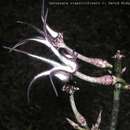pt-BR
nomes no trilho de navegação


Ceropegia stapeliiformis ist eine Pflanzenart der Gattung Leuchterblumen (Ceropegia) aus der Unterfamilie der Seidenpflanzengewächse (Asclepiadoideae) in der Familie der Hundsgiftgewächse (Apocynaceae).
Ceropegia stapeliiformis ist ein sukkulenter Strauch mit anfangs aufrechten, bald jedoch kriechenden und windend die Begleitvegetation erkletternden Stängeln. Die bis etwa ein, seltener bis 1,5 cm dicken und bis etwa einen Meter langen Zweige verzweigen nur gering weiter. Sie sind anfangs mit einem fleckigen, dunkleren Muster grün, überlaufen dann in der Sonne aber bald fleckig rotbraun und werden im Alter graubraun. Da die schuppenförmigen, gerundet dreieckigen Blätter nur etwa 3 × 4 Millimeter groß sind und meist nur wenige Wochen halten, wirken die Pflanzen fast blattlos.
Die Blüten erscheinen einzeln oder meist zu mehreren in kurz, manchmal bis zu zwei cm lang gestielten Blütenständen. Die fünf grünen Kelchblätter sind etwa vier Millimeter lang, schmal und zugespitzt. Die von den fünf verwachsenen Kronblätter gebildete Struktur ist etwa 7 × 2,5 cm groß, weiß bis grünlichweiß, mit purpurnen Flecken. Am unteren Ende wird ein länglicher Kronkessel von etwa fünf bis sieben Millimeter Durchmesser gebildet, der kontinuierlich in die gebogene, etwa zwei bis drei cm lange und nur etwa drei Millimeter dünne Kronröhre übergeht. Oben öffnet sich die Röhre trichterförmig. Die frei stehenden und abgespreizten oder miteinander verwachsenen und dann aufreißenden Kronzipfel sind schwarzpurpurnen und innen stark behaart.
Die spindelförmigen, bis 10 cm langen Balgfrüchte sind mit feinen Warzen besetzt.
Diese Art ist in der östlichen und nördlichen Kapprovinz Südafrikas beheimatet. Sie wird in zwei Unterarten mit getrennten Verbreitungsgebieten unterteilt.
Die in der Ostkapprovinz südlich des 31. Breitengrades beheimatete Ceropegia stapeliiformis subsp. stapeliiformis weist freie, deutlich abgespreizte Kronzipfel auf.
Die Kronzipfel der im Nordosten der Kapprovinz und in Eswatini nördlich des 28. Breitengrades vorkommenden Ceropegia stapeliiformis ssp. serpentina (E.A.Bruce) R.A.Dyer bleiben miteinander verbunden und bilden eine an der Spitze zusammenhängende Röhre, die zwar später meist aufreißt, jedoch nicht abgespreizt wird.
Ceropegia stapeliiformis ist eine Pflanzenart der Gattung Leuchterblumen (Ceropegia) aus der Unterfamilie der Seidenpflanzengewächse (Asclepiadoideae) in der Familie der Hundsgiftgewächse (Apocynaceae).
Ceropegia stapeliiformis is a flowering plant in the genus Ceropegia (Apocynaceae), native to South Africa and Eswatini. Common names include serpent ceropegia, snake creeper, and slangkambro.
Ceropegia stapeliiformis is a prostrate, creeping, trailing or climbing succulent creeper with fibrous roots (which develop where the stems touch the ground) and has clear sap. The leaves are minute and rudimentary, soon falling off the stems. The flowers are 5–7 cm long and have a distinctive funnel-shape with a greenish white colour that is spotted or streaked with maroon. The petals surrounding the mouth are free-spreading, reflexed and fringed with hairs. The fruit a follicle with tubercles. This species is usually found rooted in leaf mould under the protection of shrubs.
Two subspecies have been described:
The subspecies stapeliiformis is known from areas of karroid scrub in the Eastern Cape province of South Africa, with a distribution from Uitenhage and Willowmore to Graaff Reinet and King William's Town. This subspecies is known to flower from October to March.
The subspecies serpentina, which was initially described as Ceropegia serpentina by E. A. Bruce, has a distribution which ranges from Northern KwaZulu-Natal and Eswatini to Gauteng, Mpumalanga and Limpopo provinces of South Africa, where it occurs in scrub bush. The flowering time from December to March.
The names have the derivations stapeliiformis = resembling Stapelia (Latin), and sepentina = serpentine (Latin).
Ceropegia stapeliiformis is a flowering plant in the genus Ceropegia (Apocynaceae), native to South Africa and Eswatini. Common names include serpent ceropegia, snake creeper, and slangkambro.
Ceropegia stapeliiformis is a prostrate, creeping, trailing or climbing succulent creeper with fibrous roots (which develop where the stems touch the ground) and has clear sap. The leaves are minute and rudimentary, soon falling off the stems. The flowers are 5–7 cm long and have a distinctive funnel-shape with a greenish white colour that is spotted or streaked with maroon. The petals surrounding the mouth are free-spreading, reflexed and fringed with hairs. The fruit a follicle with tubercles. This species is usually found rooted in leaf mould under the protection of shrubs.
Two subspecies have been described:
Ceropegia stapeliiformis subsp. stapeliiformis Ceropegia stapeliiformis subsp. serpentina (E.A.Bruce) R.A.DyerThe subspecies stapeliiformis is known from areas of karroid scrub in the Eastern Cape province of South Africa, with a distribution from Uitenhage and Willowmore to Graaff Reinet and King William's Town. This subspecies is known to flower from October to March.
The subspecies serpentina, which was initially described as Ceropegia serpentina by E. A. Bruce, has a distribution which ranges from Northern KwaZulu-Natal and Eswatini to Gauteng, Mpumalanga and Limpopo provinces of South Africa, where it occurs in scrub bush. The flowering time from December to March.
The names have the derivations stapeliiformis = resembling Stapelia (Latin), and sepentina = serpentine (Latin).
Ceropegia stapeliiformis là một loài thực vật có hoa trong họ La bố ma. Loài này được Haw. mô tả khoa học đầu tiên năm 1827.[1]
Ceropegia stapeliiformis là một loài thực vật có hoa trong họ La bố ma. Loài này được Haw. mô tả khoa học đầu tiên năm 1827.